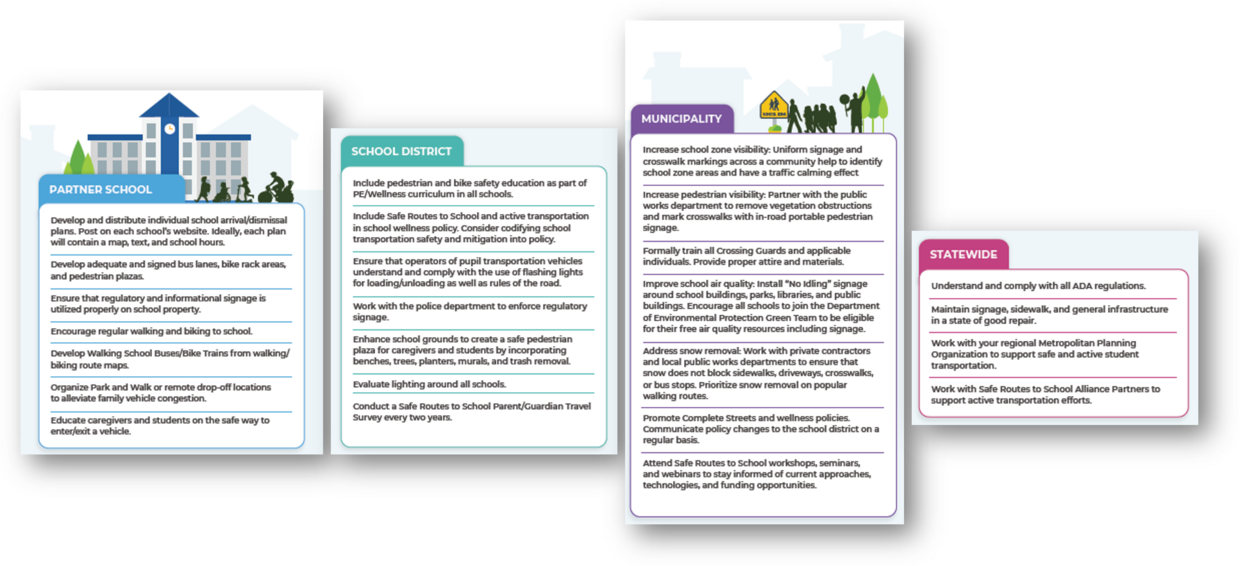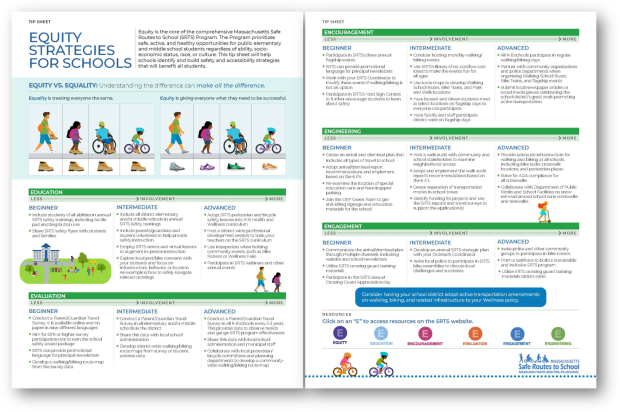Inclusion & Accessibility in Safe Routes to School Education
We invite you to learn more about inclusion and accessibility with us. Use this document to understand:
- What language we use to consistently talk about and include students with disabilities
- How to support students' specific needs so they can participate in the program
- Who to coordinate with to improve access for our students with disabilities
Massachusetts Safe Routes to School Program Sustainability
This guide is intended to support schools and municipalities in creating a sustainable SRTS program that is embedded in the core of the community. Each section provides strategies and guidance that support sustained and continued operations of an effective SRTS program, split by audience, including: Partner School, School District, Municipality, and Statewide.
Equity Strategies for Schools
Equity is the core of the comprehensive Massachusetts Safe Routes to School (SRTS) Program. The Program prioritizes safe, active, and health opportunities for public elementary, middle, and high school students regardless of ability, socioeconomic status, race, or culture. This tip sheet will help schools identify and build safety and accessibility strategies that will benefit all students.
Why Policy?
- Policy ensures that the same opportunities are implemented across all schools within a district.
- Example: The implementation of pedestrian safety instruction in all district schools provides all students with this educational benefit while focusing on the specific challenges of individual school neighborhoods. Programmatic and inconsistent participation by only a few schools in a district does not afford this opportunity to all
- Policy defines preferred behavior for everyone.
- Example: Uniform criteria for arrival and dismissal plans ensures that the same rules are followed among all district elementary, middle, and high schools and that “rules apply to everyone.”
- Equity addresses language barriers.
- Example: Parent Travel Surveys are available in nine languages common in Massachusetts.
School Wellness Policy – Amended Active Transportation Language
Working with the Massachusetts Association of School Committees, SRTS recommends that all school districts amend their Wellness Policy to include active transportation language.
The following are examples of school wellness policy amendments which can be tailored to meet the specific needs of each school district. The goal is to promote the benefits of safe walking and biking to and from school as well as to decrease parent congestion and idling. This can be accomplished by working through the SRTS program components of evaluation, education, encouragement, engagement, and engineering.
Policy Amendment Language
- The XXX Public School District will strive to accommodate all students, parents/guardians, and school staff by creating active transportation opportunities. It is the desire of the XXX Public School District to encourage principles that contribute to the safety, health, and quality of life of students by providing greater opportunities for pedestrian and bicycle trips, including the availably of bike racks, and via formal participation in the Massachusetts Department of Transportation’s Safe Routes to School program including but not limited to safety/Teacher training and ongoing walking/biking event participation.
- The XXX School District supports walking, bicycling, and other forms of active transportation to and from school and encourages efforts to minimize driving and idling when possible. The District will provide all students and teachers with pedestrian and bicycle safety education on active transportation skills and other program elements of the Massachusetts Department of Transportation’s Safe Routes to School program.
- The XXX Public School District will strive to support safe walking and biking to and from school and to decrease parent congestion and idling through the Massachusetts Department of Transportation’s Safe Routes to School program elements of education, encouragement, engagement, engineering, and evaluation.
- Facilities and Resources:
- District will provide storage facilities for bicycles, scooters, and other active transportation devices.
- Bike racks are available at all schools encouraging students to bike to school. School-wide physical activity initiatives are encouraged.
- Establish a Safe Routes to School Task Force that meets regularly to promote walking/biking to and from school and address community infrastructure issues.
- Publish arrival and dismissal plans on school websites and handbooks.

